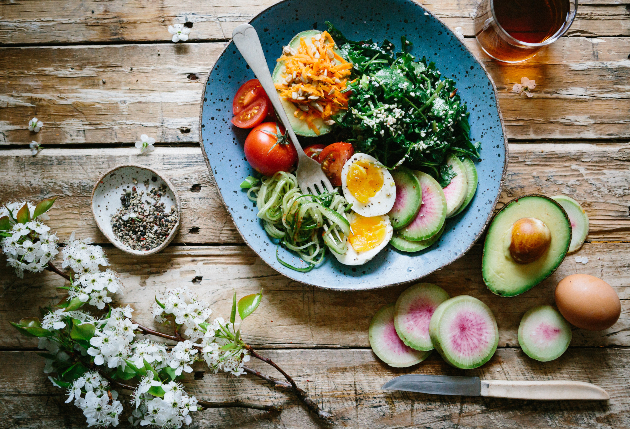Doing Whole 30 during coronavirus-induced quarantine is quite the divisive topic.
Some say it’s the best time to do it because you’re locked away in your home with no outside distractions or temptations, and nothing to do except cook. Others say you’re bored out of your mind and all you want to do is drink, while sitting on the couch, eating Flamin’ Hot Cheetos, watching Tiger King. Another big issue of discussion is obtaining the necessary ingredients to cook appropriate meals for the program. With grocery stores scarcely stocked, it can potentially be a big issue.

But as someone who completed the program (for the fourth time!) all of this March, I can tell you it’s completely doable. Not only did the clearheadedness brought on by the experience help me get through this first month of isolation, but because I cooked almost every meal from scratch, I really got acquainted with my most commonly used foods, what’s most versatile, most flavorful, most immune-boosting and what can last you the longest.
Sure, there are plenty of fun ingredients to have around that you don’t necessarily need. For example, I had a several cans of pumpkin puree lingering from fall. I hopped on to Pinterest (as I did with pretty much all my ingredients) and found out ways to make use of what I had. Suddenly it was a springtime Thanksgiving in my kitchen. But ultimately, there were only a handful of staples I felt it necessary to have on hand at all times.
With the exception of spices (you must carry an array of spices—they’re a game-changer), below are the only five main ingredients you need to make it through Whole 30 successfully.
1. Cauliflower
This versatile veggie is the ultimate breakout star of Whole 30. I went from attempting mashed potatoes cauliflower my first time doing the program, to making cauliflower smoothies and mastering the art of cauliflower rice during this fourth go. The best thing you can do for yourself (mid-Whole 30 or otherwise) is stock up on bags of pre-diced cauliflower. Trader Joe’s has aplenty. I recommend non-frozen if you want to make rice or mashed cauliflower. And then purchase a bag of frozen if you want it for your smoothie. This veggie blends with everything seamlessly, so your smoothie won’t smell like anything but berries!
2. Broth
This brings me to my next ingredient… if you hop on the cauliflower bandwagon, you’ll need broth of some sort by your side at (almost) all times. I personally opted for chicken broth, but really any full-flavored broth will do. This ingredient is crucial to mastering cauliflower rice. I posted a lot about this on Instagram Story, as it’s a very underrated, overlooked necessity. In the past, like many others shared with me, I depended on olive oil to cook my tiny cauliflower pieces, but it was never enough to cook all the way through, and always left the pieces burnt. Additionally, broth can make a fantastic addition to a homemade sauce or sauté recipe, a soup, a mash, you name it. If you have plenty left over, just pop it into Pinterest and see what you can strum up with what you’ve got.
3. A Protein or Mixed Veggies
This is a given, but important to note anyway. Having a meat of some sort or mixed veggies will make up the crop of your heavier meals. These are great to soak up the sauces you make, to slather with spices, to place atop coconut rice or mix in with zucchini noodles. It’s important to remember that soy products aren’t allowed, so if you don’t eat meat, grab on to the most versatile, flavorful veggies (mushrooms, onions and bell peppers were my go-tos this time around). Also, you can use any meat, so take advantage of that freedom (though some are encouraged more than others and you still need to read the labels for nitrates, sugars and other unapproved ingredients). I didn’t touch beef or pork, but I ate a lot of chicken and turkey bacon.
4. Eggs
Much like No. 3, it’s probably a given that eggs are key to this plan. But you’re forbidden from (most) baking, so it’s not like you need eggs for your favorite paleo banana bread loaf. Eggs, during this eating regimen, are like an old reliable friend you can call on either when you’ve got nowhere to turn, or you want to spice up the party. I had my standard moments of whipping up a turkey bacon, mushroom, onion omelette; whereas, other times, eggs were great to place atop cauliflower rice and stir-fried veggies. I’m pretty sure you don’t need me to sit here and explain all of eggs’ uses—just be sure to keep ’em handy!
5. Full Fat Canned Coconut Milk
Much like cauliflower, canned coconut milk isn’t necessarily something we actively seek out at the grocery store unless a specific recipe calls for it. Well, take on a month of Whole 30, and this coveted item will be at the top of your list. If you’re making any rendition of a cream sauce, this is your go-to. But I also found that even an unnoticeable drop here and there was called for in so many recipes.
It’s important to note the difference between Coconut Cream and Coconut Milk—they’re indeed similar, but will alter your recipe if you get the wrong one. If you can’t get both for whatever reason, always go for the milk because sometimes the top layers of the can will have the creamy consistency you can use if a recipe calls for the cream. Also, emphasis on canned and full fat. Full fat cans of these consistencies are what’s required for the majority of these recipes, so make sure you stick to them because they differ immensely from what you typically add to your coffee.











